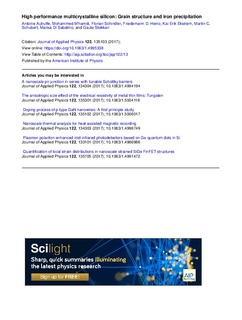| dc.contributor.author | Autruffe, Antoine | |
| dc.contributor.author | M'hamdi, Mohammed | |
| dc.contributor.author | Schindler, Florian | |
| dc.contributor.author | Heinz, Friedemann D. | |
| dc.contributor.author | Ekstrøm, Kai Erik | |
| dc.contributor.author | Schubert, Martin C. | |
| dc.contributor.author | Di Sabatino Lundberg, Marisa | |
| dc.contributor.author | Stokkan, Gaute | |
| dc.date.accessioned | 2018-01-23T12:17:14Z | |
| dc.date.available | 2018-01-23T12:17:14Z | |
| dc.date.created | 2017-10-06T08:34:58Z | |
| dc.date.issued | 2017 | |
| dc.identifier.issn | 0021-8979 | |
| dc.identifier.uri | http://hdl.handle.net/11250/2479062 | |
| dc.description.abstract | We report results from a national project about impurities in high performance multicrystalline silicon: Contamination sources, transport routes, interaction with crystal defects and impact on solar cell efficiency parameters. Several ingots were produced in a lab scale furnace. Growth parameters and crucible types were varied, and high purity quartz crucibles were compared to novel silicon nitride crucibles. The material was characterized by a range of methods including FTIR, GDMS, NAA, EBSD, dislocation etching, lifetime analysis. Wafers were processed, and lifetime was measured during the cell processing to analyse the effect of separate processing steps. Models were constructed to simulate the impurity transport during the crystallization. The diffusivity in quartz and silicon nitride crucibles required in the modelling is not generally known, and experiments were performed to evaluate them. Variations in dislocation density have the strongest impact on lifetime, even for this high quality material. The quartz crucible has the highest contamination potential, but the uncertainty in diffusion parameters makes it difficult to conclude if this potential is reached, and for which elements. We therefore make an overview showing which value of the diffusion coefficient shift the contamination dominance between feedstock/crucible/coating. The use of high purity crucibles enables comparable or even higher lifetime material to be made in lab scale compared to industrial settings. Our results indicate that a thin layer of higher purity, lower porosity quartz on the inside of the crucible can be an effective method to transfer this improvement to industrial conditions. The cell processing indicates that the diffusion/gettering sequence profoundly decreases the lifetime by rendering the random high angle grain boundaries electrically active. However, this effect is reversed after firing of the anti-reflective coating, when the remaining active defects are dislocation clusters and CSL boundaries. Silicon nitride crucibles appear to be a promising low oxygen alternative to traditional quartz crucibles in terms of purity. | nb_NO |
| dc.language.iso | eng | nb_NO |
| dc.publisher | AIP Publishing | nb_NO |
| dc.title | High performance multicrystalline silicon: Grain structure and iron precipitation | nb_NO |
| dc.type | Journal article | nb_NO |
| dc.type | Peer reviewed | nb_NO |
| dc.description.version | publishedVersion | nb_NO |
| dc.source.volume | 122 | nb_NO |
| dc.source.journal | Journal of Applied Physics | nb_NO |
| dc.source.issue | 13 | nb_NO |
| dc.identifier.doi | 10.1063/1.4995338 | |
| dc.identifier.cristin | 1502718 | |
| dc.relation.project | Norges forskningsråd: 228930 | nb_NO |
| dc.description.localcode | This is a post-peer-review, pre-copyedit version of an article published in [Journal of Applied Physics]. Locked until 1.9.2018 due to copyright restrictions. The final authenticated version is available online at: http://aip.scitation.org/doi/10.1063/1.4995338#fragmentNav_7 | nb_NO |
| cristin.unitcode | 194,66,35,0 | |
| cristin.unitname | Institutt for materialteknologi | |
| cristin.ispublished | true | |
| cristin.fulltext | original | |
| cristin.fulltext | preprint | |
| cristin.qualitycode | 1 | |
